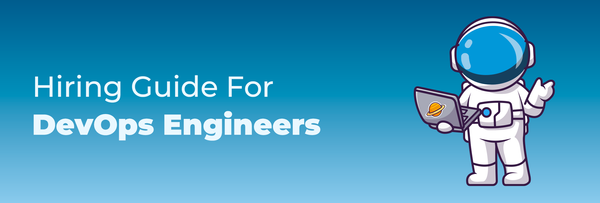Building a Remote-First Culture in Engineering Teams

Are you struggling to cultivate a cohesive and productive engineering team in a remote-first world?
You're not alone.
The shift to remote-first companies has revolutionized collaboration, presenting unique challenges and incredible opportunities.
Our blog is your ultimate guide to navigating this transformation in remote-first tech companies.
We’ll delve into strategies for building a strong remote work culture, fostering effective communication in asynchronous companies, and leveraging the right tools to keep your global remote companies connected and motivated.
Discover how the best remote-first companies turn distance into an advantage, ensuring your team thrives no matter where they are in the world.
What is a Remote-First Company?
So what does remote first mean?
A remote-first company prioritizes remote work as the default mode of operation for an organization.
In this setup, all processes, communications, and workflows are designed to support remote work, ensuring that remote employees have the same access to information and opportunities as those who may occasionally work from an office.
This approach involves creating an infrastructure that supports remote collaboration through digital tools and platforms, promoting asynchronous communication to accommodate different time zones, and fostering an inclusive environment where remote employees are equally valued and engaged.
By embracing a remote-first culture, organizations can attract a diverse talent pool, enhance employee satisfaction, and increase overall productivity, making remote work not just a possibility but a core aspect of their operational strategy.
How Can You Establish a Remote-First Work Culture in Engineering Teams?
Creating a remote-first work culture involves a thoughtful and comprehensive approach that goes beyond simply allowing employees to work from home.
It requires reimagining how your organization operates, communicates, and collaborates.
- Redefining Communication Norms
Start by redefining communication norms.
Promote asynchronous communication, where messages are not expected to be answered immediately, allowing software development team members across different time zones to contribute without the pressure of being constantly online.
Establish clear communication channels, using tools like Slack for instant messaging, email for formal communication, and video conferencing tools like Zoom for meetings.
Guidelines for when and how to use each tool can help avoid communication overload.
According to a recent survey, 52% of employees express a preference for asynchronous communication over synchronous methods.
Additionally, 42% of respondents view asynchronous communication as the direction in which the future of work is headed.
- Investing in Digital Tools
As per Statista's forecasts, global spending on digital transformation is anticipated to reach $3.4 trillion by the year 2026 which shows how investing in digital tools is crucial to stay ahead of the game.
If you are wondering how to manage an engineering team remotely, consider investing in digital tools.
Collaboration platforms like Trello, Asana, or Monday.com can help manage projects and tasks effectively by providing visibility into project progress and individual contributions, fostering transparency and accountability.
Use tools like Google Workspace or Microsoft 365 for real-time document collaboration, ensuring that all documents are stored in a central, accessible location to prevent information silos.
Did you know that in 2021, digital collaboration tools were utilized by 79% of workers globally?
- Fostering an Inclusive Environment
Fostering an inclusive environment is essential as inclusive teams demonstrate over a 35% increase in productivity.
Ensure that all meetings, whether synchronous or asynchronous, are designed to include remote employees.
Use video conferencing tools to bring everyone together and record meetings for those who cannot attend.
Host virtual events like online games, coffee breaks, or team-building exercises to help remote employees feel connected and part of the team.
Remote work across different time zones can hinder employees' ability to connect, with 55% reporting feelings of loneliness during their workdays.
To foster better relationships with your team, consider the following ideas for hosting various virtual meetings:
- Virtual Coworking Sessions:
These sessions replicate the coworking experience virtually, allowing remote employees to work together and provide mutual motivation.
Participants join a web conferencing call, share their screens, and work alongside each other.
- Virtual Games:
Break up the workday with virtual games like online pictionary or virtual escape rooms.
These activities promote team bonding while enhancing problem-solving and teamwork skills.
- Virtual Talent Shows:
Encourage employees to showcase their talents, such as playing an instrument or dancing, in virtual talent shows.
- Virtual Workshops:
Offer virtual workshops where employees can learn new skills unrelated to their jobs, such as yoga or language lessons, to enhance their well-being and personal development.
- Emphasizing Results Over Hours
Emphasizing results over hours is another key strategy.
Shift the focus from hours worked to results achieved by setting clear expectations and measurable goals, and trust employees to manage their own time effectively.
Allow employees to set their schedules within reason, as long as they meet their deadlines and attend necessary meetings.
- Providing Adequate Support and Resources
Providing adequate support and resources is also vital.
Offer stipends for employees to set up a comfortable and productive home office environment, including funding for ergonomic furniture, high-speed internet, and necessary office supplies.
Ensure that remote employees have access to IT support to help them troubleshoot any technical issues quickly.
- Providing Supportive Remote-First Leadership
Wondering how to become an engineering team leader?
The responsibilities of remote-first leaders and team managers are considerable: safeguarding and prioritizing the physical and mental well-being of their software engineering teams and themselves.
In the absence of physical presence, detecting signs of burnout or physical discomfort among team members can be challenging.
Did you know that approximately 40% of individuals working remotely find it challenging to disconnect from their work, resulting in a higher incidence of burnout compared to office-based employees?
This trend is particularly evident among full-time remote workers, with 86% reporting experiencing burnout
Start by ensuring you have a clear understanding of your employees' workloads.
This enables you to proactively remove obstacles and encourage feedback when your direct reports require assistance.
It also aids in recognizing instances of overwork, avoiding the establishment of unrealistic expectations and deadlines, and mitigating stress.
Additionally, establish procedures that allow individuals to take time off and recuperate adequately. This encompasses both off-work hours and vacation time.
Employees should not experience anxiety when offline, and returning from a break should not feel overwhelming.
As a leader, you must prioritize self-care as well.
You deserve rest, and setting this example sends a powerful message to your team.
If team leaders and directors do not utilize their paid time off (PTO), employees may perceive an expectation to work continuously and minimize breaks and vacations.
- Cultivating a Strong Company Culture
Cultivating a strong company culture is critical.
Communicate the company’s core values and mission clearly and consistently, ensuring that remote employees understand how their work contributes to the organization’s goals.
Regularly recognize and celebrate the achievements of remote employees, providing constructive feedback and opportunities for professional development.
- Regular Check-ins and Feedback Loops
Regular check-ins and feedback loops are necessary to maintain a healthy remote-first culture.
Schedule regular one-on-one meetings between managers and remote employees to discuss progress, address concerns, and provide support.
Inadequate performance feedback could prompt around 24% of employees to contemplate resigning from their positions.
Moreover, 41% of employees have resigned from their positions due to feeling unheard or undervalued.
This is where employee feedback comes into play.
Use tools like surveys or feedback platforms to gather input from remote employees about their experiences and areas for improvement.
Fun Fact: Companies with recognition programs experience a 14% increase in employee productivity, performance, and engagement.
- Adapting Policies and Procedures
Finally, adapt policies and procedures to support remote work.
Develop clear remote work policies that outline expectations, communication norms, and guidelines for remote work, ensuring these policies are easily accessible to all employees.
Adapt onboarding processes to ensure new remote employees receive comprehensive training and support as they acclimate to the company’s remote-first culture.
Building a remote-first work culture is an ongoing process that requires commitment and continuous improvement.
By prioritizing effective communication, investing in the right tools, fostering inclusivity, focusing on results, and providing ample support, organizations can create a thriving remote-first environment.
This not only enhances productivity and employee satisfaction but also positions the organization to attract and retain top talent from around the globe.
Supercharge Your Team Today with Teamo's 10x Talent Solution
Unlock the power of your business with Teamo, your gateway to a superteam of 10x Talent!
Revolutionize your development team with our cutting-edge talent solution, accessing top-tier, pre-screened software developers from emerging markets.
Seamlessly integrate these remote powerhouses into your projects for unparalleled efficiency and success.
- Seamless Integration: Teamo ensures a smooth integration process, allowing your new talent to seamlessly join your development team and hit the ground running.
- Fast and Affordable: Experience rapid results without breaking the bank. Teamo offers fast and affordable access to top talent, helping you achieve your business goals without compromising quality.
- Extensively Vetted: Rest assured knowing that all our developers undergo rigorous vetting processes, ensuring you receive only the best candidates for your projects.
Elevate your business to new heights with Teamo. Get started today and witness the transformative power of 10x Talent!
FAQs
- What does remote first mean?
"Remote-first" culture refers to an organizational approach where remote work is prioritized as the primary mode of operation for the majority, if not all, of employees.
Essentially, in a remote-first setup, the expectation is that only a limited number of individuals, if any, are consistently mandated to conduct their job responsibilities from a central office location.
- What are the common components of a software engineering team structure?
Typically, a software engineering team structure comprises roles such as software engineers, team leads or managers, quality assurance specialists, product managers, and possibly designers or architects.
These roles work together to conceptualize, develop, test, and deploy software products.
- What are the different types of software engineering team structures?
There are various types of software engineering team structures, including:
- Hierarchical Structure: Traditional structure with clear levels of authority and reporting lines.
- Matrix Structure: Cross-functional teams formed temporarily to accomplish specific projects.
- Flat Structure: Minimal hierarchy with teams organized around projects or areas of expertise.
- Holacracy: Self-organizing teams without traditional management hierarchies, focused on distributed decision-making.




